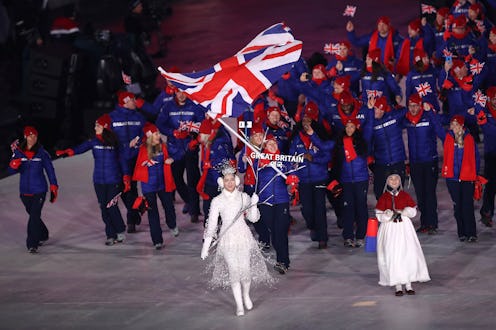News
There’s A Meaningful Reason Behind The Order Of The Parade Of Nations

One of the most anticipated events of the Olympic opening ceremony is the parade, in which the athlete delegation from each country enters the PyeongChang Olympic Stadium bearing their flag. As with everything else in the ceremony, the order in which the countries enter is symbolically important. So, here's the order of countries during the Parade of Nations in the 2018 Winter Olympics.
Exactly 92 nations, as well as a partial delegation from Russia, were in this year's parade. That's the biggest number in history, and it includes the Winter Olympic newcomers of Singapore, Eritrea, Malaysia, Ecuador, Nigeria, and Kosovo. The biggest delegation is from the United States and includes 242 athletes. The U.S. delegation is also the largest in the history of the Olympics. Many countries have very small delegations, though; Albania, for example, sent just two athletes to the games.
Greece enters first, as always, because they are the creators of the Olympic tradition. The host nation — South Korea, this time — always goes last. South Korea and North Korea are marching together under one Korean unification banner this year. Beyond that, the countries will enter alphabetically according to the Korean alphabet. Here's the official order:
1. Greece
2. Ghana
3. Nigeria
4. South Africa
5. Netherlands
6. Norway
7. New Zealand
8. Denmark
9. Germany
10. Democratic Republic of Timor-Leste
11. Latvia
12. Lebanon
13. Romania
14. Luxembourg
15. Lithuania
16. Liechtenstein
17. Madagascar
18. Malaysia
19. Mexico
20. Monaco
21. Morocco
22. Montenegro
23. Republic of Moldova
24. Malta
25. Mongolia
26. United States of America
27. Bermuda
28. Belgium
29. Belarus
30. Bosnia and Herzegovina
31. Bolivia
32. Bulgaria
33. Brazil
34. San Marino
35. Serbia
36. Sweden
37. Switzerland
38. Spain
39. Slovakia
40. Slovenia
41. Singapore
42. Armenia
43. Argentina
44. Iceland
45. Ireland
46. Azerbaijan
47. Andorra
48. Albania
49. Eritrea
50. Estonia
51. Ecuador
52. Great Britain
53. Australia
54. Austria
55. Olympic Athletes from Russia
56. Uzbekistan
57. Ukraine
58. Islamic Republic of Iran
59. Italy
60. Israel
61. India
62. Japan
63. Jamaica
64. Georgia
65. People’s Republic of China
66. Czech Republic
67. Chile
68. Kazakhstan
69. Canada
70. Kenya
71. Kosovo
72. Colombia
73. Croatia
74. Kyrgyzstan
75. Cyprus
76. Chinese Taipei
77. Thailand
78. Turkey
79. Togo
80. Tonga
81. Pakistan
82. Portugal
83. Poland
84. Puerto Rico
85. France
86. The Former Yugoslav Republic of Macedonia
87. Finland
88. Philippines
89. Hungary
90. Hong Kong, China
91. North and South Korea
The name of each country is announced in three languages: French, English, and Korean. French and English are the official languages of the Olympic Games.
Russian athletes were able to join the parade, but because of the recent doping scandal that threatened the Olympic participation of its entire delegation, it was not permitted to do so in the glorified manner of the other nations. Its athletes did not bear the Russian flag or wear Russian paraphernalia. Instead, they wore gray coats and white scarves and marched under the Olympic flag.
Besides the more somber aesthetic of the Russian athletes, one of the most notable parts of the ceremony was the unified delegation of the two Koreas. Commenting on this event — which had not happened in over a decade — the president of the International Olympic Committee, Thomas Bach, spoke to the crowd of "the unique power of sport to unite people."
"A great example of this unifying power is the joint march here tonight of the two teams from the National Olympic Committees of the Republic of Korea and the Democratic People’s Republic of Korea," he said. "We thank you."